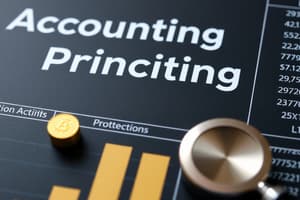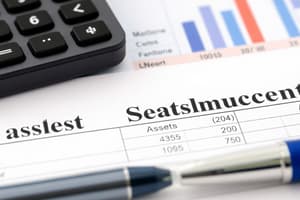Podcast
Questions and Answers
How is an asset defined for accounting purposes?
How is an asset defined for accounting purposes?
- An economic resource controlled due to past events. (correct)
- A physical item owned by the business.
- A resource that generates profits indefinitely.
- A right without any economic value.
Which of the following is NOT classified as a current asset?
Which of the following is NOT classified as a current asset?
- Cash and cash equivalents.
- Accounts receivable.
- Inventory expected to be sold within a year.
- Property, plant, and equipment. (correct)
Which of the following best describes non-current assets?
Which of the following best describes non-current assets?
- Assets acquired to retain and generate profits over time. (correct)
- Assets that are expected to be sold within 12 months.
- Financial resources that are controlled temporarily.
- Liabilities that must be settled within a year.
Which of the following is typically classified under current liabilities?
Which of the following is typically classified under current liabilities?
What type of assets are referred to as intangible assets?
What type of assets are referred to as intangible assets?
Which of the following is a key characteristic of non-current assets?
Which of the following is a key characteristic of non-current assets?
Which of the following would typically be classified as a current asset?
Which of the following would typically be classified as a current asset?
What is an essential element for an item to be classified as an asset?
What is an essential element for an item to be classified as an asset?
Which of the following correctly describes intangible assets?
Which of the following correctly describes intangible assets?
What would classify as a non-current asset?
What would classify as a non-current asset?
Flashcards are hidden until you start studying
Study Notes
Assets
- An asset is owned by its owner and is worth something to its owner
- An asset is any right which is of economic value to its owner.
- For accounting purposes, an asset is a present economic resource controlled by the entity as a result of past events.
- Non-current assets are assets that are acquired by the business with the intention of retaining them within the business to help generate profit
- Examples of non-current assets: property, plant and equipment, investment property, financial assets, intangible assets
Liabilities
- Liabilities are obligations of the company.
- Current liabilities are obligations that are expected to be settled within the next 12 months.
- Examples of current liabilities: Accounts payable, salaries payable, interest payable, income tax payable.
Assets
- An asset is owned by its owner and is worth something to its owner
- An asset is any right that is of economic value to its owner
- For accounting purposes, an asset is a present economic resource controlled by the entity as a result of past events
- Non-current assets are acquired by the business with the intention of retaining them within the business to help generate profit
- Examples include Property, plant and equipment. Investment Property, Financial assets, Intangible assets
- Current assets are expected to be converted into cash, sold or consumed within the business's normal operating cycle
- Current liabilities are obligations that are expected to be settled within the business's normal operating cycle
- Examples of current liabilities include Trade Payables, Accrued Expenses, Short-Term Loans, Deferred Tax, and Tax and Social Insurance
- Long-term liabilities are obligations with a maturity date that is longer than 12 months from the balance sheet date
- Examples of long-term liabilities include Long Term Borrowings, Defered Tax, Long Term Provisions
Studying That Suits You
Use AI to generate personalized quizzes and flashcards to suit your learning preferences.




